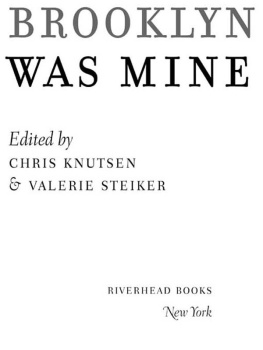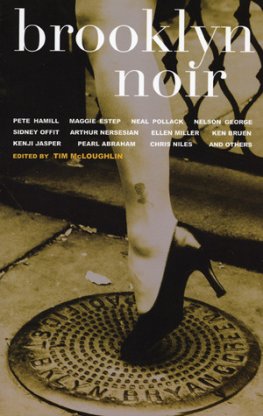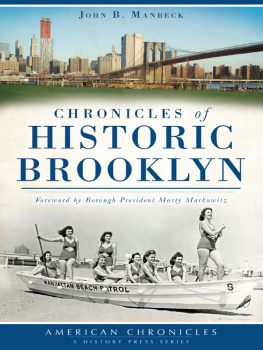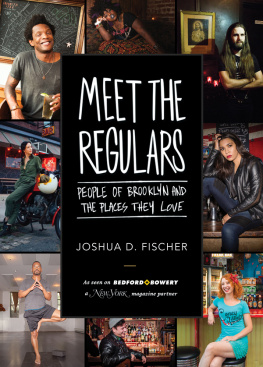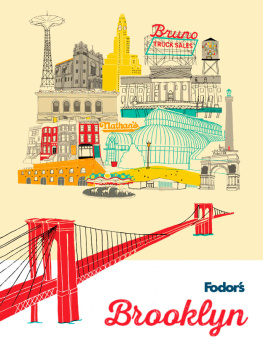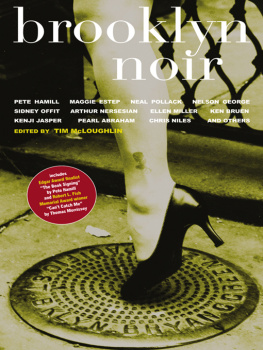BROOKLYN WAS MINE
Edited by CHRIS KNUTSEN & VALERIE STEIKER
RIVERHEAD BOOKS
New York
RIVERHEAD BOOKS
Published by the Penguin Group
Penguin Group (USA) Inc.
375 Hudson Street, New York, New York 10014, USA Penguin Group (Canada), 90 Eglinton Avenue East, Suite 700, Toronto, Ontario M4P 2Y3, Canada (a division of Pearson Penguin Canada Inc.) Penguin Books Ltd., 80 Strand, London WC2R 0RL, England Penguin Group Ireland, 25 St. Stephens Green, Dublin 2, Ireland (a division of Penguin Books Ltd.) Penguin Group (Australia), 250 Camberwell Road, Camberwell, Victoria 3124, Australia (a division of Pearson Australia Group Pty. Ltd.) Penguin Books India Pvt. Ltd., 11 Community Centre, Panchsheel Park, New Delhi110 017, India Penguin Group (NZ), 67 Apollo Drive, Rosedale, North Shore 0632, New Zealand (a division of Pearson New Zealand Ltd.) Penguin Books (South Africa) (Pty.) Ltd., 24 Sturdee Avenue, Rosebank, Johannesburg 2196, South Africa
Penguin Books Ltd., Registered Offices: 80 Strand, London WC2R 0RL, England
The publisher has no control over and does not assume any responsibility for author or third-party websites or their content.
Permission to excerpt letters and notes in Reading Lucy by Jennifer Egan courtesy of the Brooklyn Historical Society; Alfred Kolkin and Lucille Gewirtz Kolkin Collection, 19421965, the Brooklyn Historical Society.
Collection copyright 2008 by Chris Knutsen and Valerie Steiker
Stepback illustration of Brooklyn by Jonathan Bennet
All rights reserved.
No part of this book may be reproduced, scanned, or distributed in any printed or electronic form without permission. Please do not participate in or encourage piracy of copyrighted materials in violation of the authors rights. Purchase only authorized editions.
RIVERHEAD is a registered trademark of Penguin Group (USA) Inc.
The RIVERHEAD logo is a trademark of Penguin Group (USA) Inc.
Library of Congress Cataloging-in-Publication Data
Brooklyn was mine / edited by Chris Knutsen and Valerie Steiker. 1st Riverhead trade pbk. ed.
p. cm
ISBN: 978-1-1012-1753-5
1. Brooklyn (New York, N.Y.)Description and travel. 2. Brooklyn (New York, N.Y.)Social life and customs. 3. City and town lifeNew York (State)New York. 4. Street lifeNew York (State)New York. 5. Authors, AmericanHomes and hauntsNew York (State)New York. 6. Authors, AmericanNew York (State)New YorkBiography. 7. New York (N.Y.)Description and travel. 8. New York (N.Y.)Social life and customs. I. Knutsen, Chris. II. Steiker, Valerie.
F129.B7B823 2008
974.7'23043dc22 2007037006
What is it then between us?
What is the count of the scores or hundreds of years between us?
Whatever it is, it avails notdistance avails not,
and place avails not, I too lived, Brooklyn of ample hills was mine
WALT WHITMAN , Crossing Brooklyn Ferry
CONTENTS
INTRODUCTION
Phillip Lopate
NOT SO MUCH when world-weary as when Im feeling chipper, I saunter over from my house to the Union Street Bridge, to take in the restorative waters of the much-maligned Gowanus Canal. I live on Sackett Street, one block north of Union, so first I walk over to Union Street and then go left, past the modest brick three-story homes with their stoops and stone angel fountains and religious decorations and patriotic American flags and an occasional Italian tricolor, this being a longstanding Italian neighborhood, where gangster Al Capone grew up and immigrant stevedores labored on Brooklyn docks to raise a roof over their families heads, with a renter downstairs. These are not the fancy brownstones nowadays selling for several million, but awkward, cozy row houses, whose lack of cachet increases as you approach the canal. Essentially, no one of class ever wanted to live near the Gowanus, legendary for its stink and for mobsters bodies fished out of the canal; rumor had it that if you were unfortunate enough to fall in, your bones would be dissolved by acids instanter.
The old Gowanus creek had been enlarged in the 1840s to service nearby factories and move construction materials for the burgeoning habitations of Brooklyn; and this dinky little canal, one hundred feet wide and less than a mile long, no deeper than fifteen feet in high water, became one of the most trafficked watercourses of nineteenth-century America. By then it had already become so polluted an 1893 newspaper could call it an open cesspool. In the twentieth century, it devolved into a one-use channela conveyer of heating oil, whose toxic leakage into the creek bottom and the nearby shores sediment complicated any future development for recreational or residential uses. They would all have to be treated as brownfields and laboriously cleansed at enormous cost. This daunting proposition has not prevented local community planners from fantasies of converting the lowly Gowanus Canal into Little Venice, with outdoor cafs hugging the narrow banks. (Inshallah, it will never happen.) The tides being too sluggish to rid the channel of pollutants, a flushing tunnel has been installed, whose pumping action goes a long way toward alleviating olfactory insult. Domestic oil continues to be transported intermittently by barge, necessitating the raising of the Union Street drawbridge, a pokey operation that leads local drivers to lean on car horns and curse their fate. There is also another Gowanus Canal drawbridge, two blocks south on Carroll Street, older and more charmingly wood-planked, with verdant views almost Last-of-the-Mohicans primeval; but for some reason I keep being lured to the funkier Union Street Bridge.
Standing on the span, looking outward toward the north, I see what is most astonishing for this city: a good deal of sky and clouds above low-scaled structures, and a vast sweeping view of Brooklyn that would have quickened the pulse of any Delft landscape painter. You can luxuriate in the profligate empty space (waste, to a developers eye) framed by the canal. At the canals northern terminus fly the national and city flags of the NYC Department of Environmental Protection substation. In the distance, the deco crown of the Williamsburgh Savings Bank Tower, the tallest building in Brooklyn, at one time its only legitimate high-rise, and until recently a haven for dentists offices, though now being inevitably converted into condos, towers over the Wyckoff Houses, a public-housing complex whose white-brick facades make it appear more hopeful or at least less stigmatized than the usual grim red project brick of the Gowanus Houses, glowering to the right. On the canals western bank, a small grassy meadow with wild-flowers, bisected by oil pipes, slopes down to the greenish, petroleum-iridescent water. Along the eastern bank are lined the back ends of mostly abandoned factories, painted with graffiti and faded words like Conklin Brass. The thump-thump of cars passing over the bridges metal plates contributes to the contemplative mood.
If I cross the road and look south, toward Red Hook, there appears a parking lot filled with Verizon telephone trucks, in the distance the elevated trestle of the F train, and the Kentile Floors sign, and a factory placard that reads Alex Figliola Contracting: Water Mains and Sewers. Across the bridge, on the Park Slope side, is a proliferation of auto-body shops. All this prosaic attention to infrastructure and repair, strewn haphazardly on either side of the canal amid weeds and ailanthus trees, this strange combination of industrial, residential, and bucolic, speaks to the plain, somnolent essence of Brooklyn. The genius of Brooklyn has always been its homey atmosphere; it does not set out to awe or intimidate, like skyscraper Manhattanwhich is perhaps why one hears so much local alarm at the luxury apartment towers that have started to sprout up, every two blocks, in those parts of the borough lying closest to Manhattan. Much of the chagrin is expressed by people who have moved here from elsewhere; I, a native Brooklynite, never romanticized the place as immune from modernity, nor do I see why such an important piece of the metropolis should be protected from high-rise construction when the rest of the planet is not. But my feelings are mixed: for if the sleeping giant Brooklyn were to awake and truly bestir itself and turn into a go-getter, I would deeply regret the loss of sky. Perhaps it is some deep-seated, native-son confidence that Brooklyn will never quite get it together, which allows me to anticipate its bruited transformation with relative sanguinity. Meanwhile, I stand on the Union Street Bridge, a fine place from which to contemplate the Brooklyn that was, that is, and that is to be.

